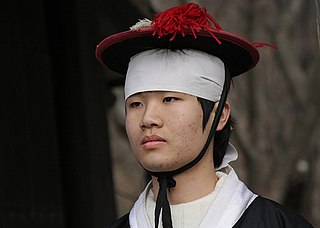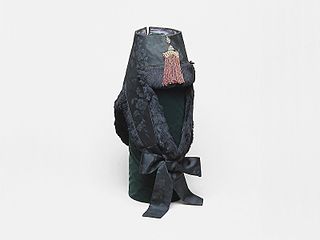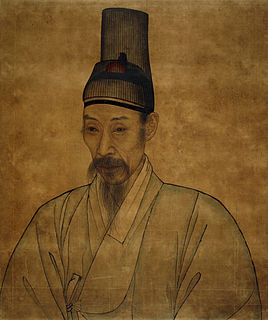 W
WAn ayam (아얌) is a Korean traditional winter cap mostly worn by women in the Joseon period for protection against the cold. It is also called aegeom which literally means "covering a forehead" in Korean. There is a historical record which mentions that officials in a low class called iseo wore ayam in the early Joseon period, so it was a unisex cap. However, it is not clear whether the shape at that time was identical to that of the later period. During the late Joseon period, an ayam was usually worn by female commoners. Especially in the western part of Korea, kisaeng commonly wore an ayam, and they were also worn as a simple formal headgear.
 W
WA beonggeoji is a Korean hat worn by military officers in a low class or servants of yangban, aristocrats during the Joseon Dynasty. It is also called jeonnip or byeongnip. It began to be worn in the northwestern region of Korea and was spread to nationwide after Imjin Waeran (1592–1598) and Second Manchu invasion of Korea (1636) occurred.
 W
WChengziguan is a type of guanmao (冠帽), a men's traditional hat originated in China, dates back to the Five Dynasties and Ten Kingdoms period. It's said that this kind of headgear was usually worn by Chinese Song Dynasty philosopher Cheng Hao and his brother Cheng Yi, therefore it's called Chengziguan, which literally means “the hat of the Cheng”. Chengziguan is made with horse hair.
 W
WCheopji (hangul:첩지 ;hanja:疊紙) is a Korean hair accessory decorating the chignon of ladies when they wear a ceremonial dress. It is usually made of silver, and a frog-shape is its common form. The use of cheopji began after Baljaegaeheok proclaimed by Yeongjo of Joseon. It was used routinely at court, but ordinary people were to use this only when they wear a ceremonial dress.
 W
WThe Asian conical hat, commonly known as an Asian rice hat, coolie hat, oriental hat or farmer's hat, is a simple style of conical hat originating in East, South and Southeast Asia; and notable in modern-day nations and regions of Bangladesh, Bhutan, China, Cambodia, Northeast India, Indonesia, Japan, Korea, Thailand, Laos, Malaysia, Myanmar, Nepal, Philippines, parts of Outer Manchuria, Taiwan, and Vietnam.
 W
WDaenggi is a traditional Korean ribbon made of cloth to tie and to decorate braided hair. According to the History of Northern Dynasties, maidens of Baekje bound their hair at the back and braided it, while a married women braided her hair into two plaits and secured them to the crown of her head.
 W
WThe gache is a big wig worn by Korean women. Women of high social backgrounds and kisaeng wore them. Like their western contemporaries Koreans considered bigger and heavier wigs to be more aesthetically pleasing. However, there is a record of an incident where a heavy gache wig led to the death of a 13-year-old bride as the heavy wig compromised her neck as she was getting up to greet her father-in-law entering the room. Also due to its costliness, some lower-class families took up to 6–7 years preparing a new gache wig for their new daughter-in-law.
 W
WA gat is a type of Korean traditional hat worn by men along with hanbok during the Joseon period. It is made from horsehair with a bamboo frame and is partly transparent black in color.
 W
WA gulle is a type of sseugae (쓰개), Korean traditional headgear, worn by children aged one year to five years old during the late Joseon period. It was mostly worn by young girls in the upper class for warmth and style. Gullae was usually made with silk and in summer, it was made with sa, a type of silk loosely woven.
 W
WA hogeon is a type of gwanmo (관모), Korean traditional headgear for young boys aged one year to five years old. It was worn along with durumagi (overcoat) or jeonbok. Hogeon was worn on holidays such as Seollal, Chuseok, or celebrations for their birthdays like doljanchi. The shape and material are almost similar to bokgeon except a tiger pattern embroidered on hogeon. The outer is made of a black silk while the inner is dark blue silk. The tiger pattern was embroidered on the surface as reflecting parents' wish for their children to grow brave. The shapes of a tiger's eyebrow, eyes, whiskers, teeth and ears are decorated on the forehead of the hogeon. The ears was made with black and red fabrics. Strings attached to the end of the forehead part is able to tie the headgear to its back. Along with the tiger pattern, geumbak of some of Hanja that had good and auspicious meaning are adorned with the hogeon to bless the wearer. It was worn by young boys until they reached to the age of 5 or 6 years old.
 W
WHwagwan is a type of Korean coronet worn by women, traditionally for ceremonial occasions such as weddings. It is similar to the jokduri in shape and function, but the hwagan is more elaborate.
 W
WA jobawi is a type of traditional Korean winter cap with earflaps which was worn by women and was made of silk. Since its first appearance in the late Joseon period, it has been widely worn as a substitute for the ayam. Although the jobawi was worn by the upper class as well as by commoners, it was mostly used by the yangban aristocracy of that time as a decorative headgear when they went out. In addition, the jobawi was worn not only as formal headgear, but also for special occasions. Even though a wearer was not in formal attire, if she wore a jobawi, the overall outfit could be considered as simple formal clothing.
 W
WA jokduri is a type of Korean traditional coronet worn by women for special occasions such as weddings. It consists of an outer crown which is covered with black silk, and the inner which is filled with cotton and hard paper. Its top is decorated with cloisonné ornaments. The crown is also called jokdu or jokgwan and is used mostly as an accessory. The upper part is vaguely hexagonal and the bottom is cylindrical. The form of jokduri gets narrower from the top to the bottom. jokduri can be used to display the wearer's social status by being adorned with accessories made from gold or silver.
 W
WA nambawi is a type of traditional Korean winter hat worn by both men and women during the Joseon period for protection against the cold. The other names for it are pungdengi and nani. The nambawi is also called ieom which was worn in the early Joseon period, although it was derived from the cap. It was originally worn by the upper class as a daily hat, but spread to commoners and women in the later period. It was usually worn by middle-aged women and old people as well as by government officers who put it under the samo.
 W
WA pungcha is a type of traditional Korean winter hat worn by both men and women during the Joseon period for protection against the cold. It is also called pungchae and jeongpungcha. Although its shape is very similar with nambawi, the pungcha has a bolkki (볼끼) attached on both sides of the ears. It was originally worn by males of yangban, the upper class but became to spread to commoners including women.
 W
WSangmo (상모) is a Korean folk arts hat. A kind of a hat with feathers or paper streamers called Pi-Ji, made of Korean paper attached to the top which is worn when dancing and moving the head around during a Pungmul(nongak) performance.
 W
WTanggeon is a type of Korean traditional headgear worn by men, which is put under a gat. It is usually made of dyed horsehair or cow hair. Artisans who specialize in making tanggeon are called tanggeonjang.
 W
WWangjin is a kind of traditional headband worn by adult men in Chinese Ming Dynasty, Korean Joseon period, Vietnam Later Lê dynasty to Nguyễn dynasty and Ryukyu Kingdom to hold their hair in place after the topknot is done. It is usually made by weaving dyed horsehair.
 W
WA yanggwan or liangguan(梁冠) is a ceremonial hat worn by Korean and Chinese officials during events such as a wedding ceremony, prayer ceremony like that practiced on Chuseok, and other ceremonies. It is considered a crown. It is usually worn when "court dress" (朝服) is required for Korean officials.